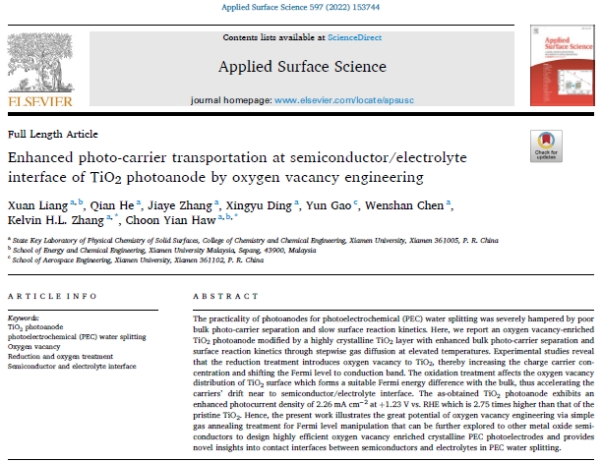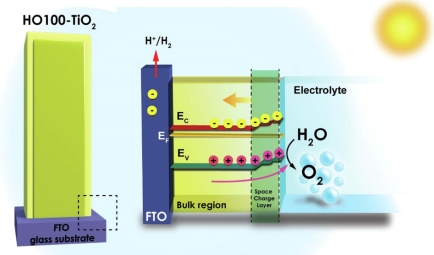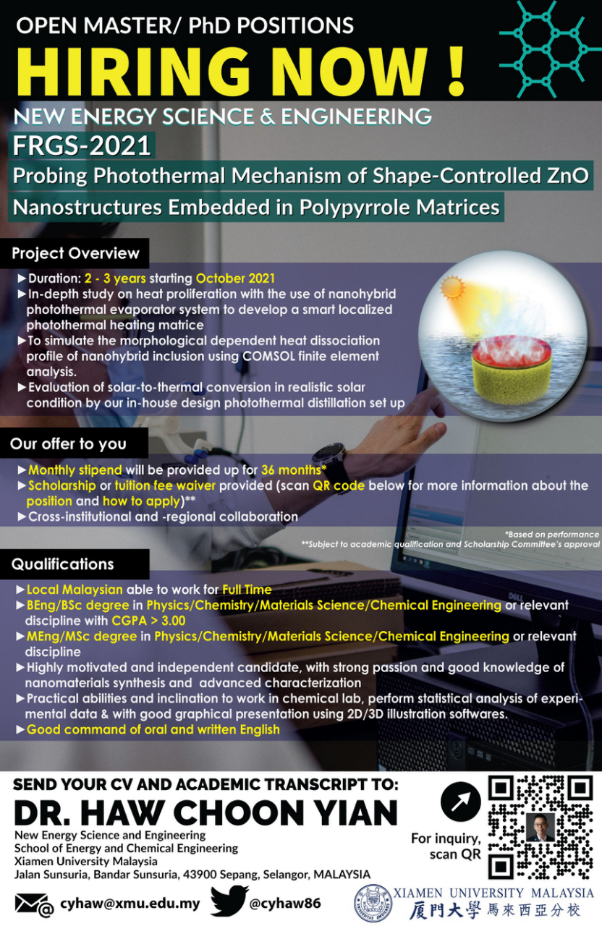The Centre for Postgraduate Studies and Research congratulates Assistant Professor Dr. Haw Choon Yian from XMUM School of Energy and Chemical Engineering for publishing a research article in Applied Surface Science, a Tier 1-SCI journal with a latest impact factor of 6.707, as one of the corresponding authors.
Liang Xuan, the first author of this article, has recently obtained a master’s degree from the State Key Laboratory of Physical Chemistry of Solid Surfaces, College of Chemistry and Chemical Engineering, Xiamen University China (XMU). He completed his postgraduate studies under the supervision of Dr. Haw Choon Yian and Prof. Kelvin Zhang Hong-Liang.
This work signifies the collaboration between XMUM School of Energy and Chemical Engineering and XMU College of Chemistry and Chemical Engineering for joint supervision of master students, as Liang Xuan is the first such jointly supervised student.
With the title of “Enhanced photo-carrier transportation at semiconductor/electrolyte interface of TiO2 photoanode by oxygen vacancy engineering”, in this article, the authors report the facile route in preparing highly concentrated oxygen vacancy (Vo) in the TiO2 crystalline photoanode modulating by stepwise hydrogen and oxygen heat treatment. The findings reveal that the oxygen-defected TiO2 photoanode shows excellent charge separation efficiency in the bulk TiO2 and serves as a charge transfer channel on the TiO2 surface state to facilitate the photo-carrier transportation at the semiconductor/electrolyte interface for water oxidation in PEC. The present work aims to contribute as an insightful reference for the synthesis of defective PEC photoelectrode to achieve high activities for PEC water splitting reaction.
“I am grateful to Dr. Haw and Prof. Zhang for their guidance and encouragement,” said Liang Xuan. “This joint project allows me to enjoy the fruit of the internationalization of XMU, which has broadened my horizons while improving my critical thinking and language skills.”
“We have been working on this project since 2020 when COVID-19 pandemic hits us,” said Dr. Haw Choon Yian. “In times of crisis, we decided to complete the project by phases starting from sample preparation, characterizations, consolidation of results, and manuscript drafting. It took months for all stages to be completed and the project was also susceptible to lab accessibility issues caused by Covid-19 lockdown. Despite this being an agonizing process, the hardship really paid off.
“Special thanks to all the excellent team members at the College of Chemistry and Chemical Engineering and the School of Aerospace Engineering, XMU China for their continuous support for this work.”

The article can be accessed at https://doi.org/10.1016/j.apsusc.2022.153744

Careful modulating the concentration of oxygen vacancies (Vo) of TiO2 nanorods through sequential hydrogen and oxygen heat treatment enhances charge carrier transportation in the bulk to the semiconductor/electrolyte interface for PEC oxidation.
Dr. Haw Choon Yian serves as Assistant Professor at XMUM School of Energy and Chemical Engineering, with an adjunct appointment at the College of Chemistry and Chemical Engineering, Xiamen University. He is also the Head of Programme of XMUM’s Master in New Energy Science and Engineering research programme. His research interests include the synthesis of metal oxides and chalcogenides nanomaterials with tunable dimensions for renewable energy applications such as photoelectrochemical and photocatalytic water splitting hydrogen production, photothermal energy conversion, wastewater treatment, and biomedical applications.
Dr. Kelvin Hong-Liang Zhang is a Professor at the College of Chemistry and Chemical Engineering, Xiamen University. His current research interests focus on the synthesis and properties of complex metal oxide thin films and heterostructures relevant to application in oxide electronics and electrocatalysts. He obtained his Ph.D. degree in chemistry from Oxford University in 2012, followed by working as a postdoc at Pacific Northwest National Laboratory and as a Herchel Smith Fellow at the University of Cambridge from 2015 to 2017.







